Ao selecionar luminárias de LED ou projetar soluções de iluminação LED, muitas pessoas geralmente encontram um problema confuso: qual é a diferença entre “lúmens” listados na embalagem e “lux” nas especificações de design?
Na verdade, embora tanto os lúmens quanto o lux estejam relacionados ao “brilho”, eles se concentram em aspectos totalmente diferentes: os lúmens medem a quantidade de luz que uma luminária emite, enquanto o Lux mede a quantidade de luz que uma superfície recebe.
Algumas pessoas erroneamente acreditam que quanto mais altos os lúmens, mais brilhantes são as luzes, enquanto outras tratam erroneamente o Lux como um parâmetro fixo do dispositivo. Esses mal-entendidos geralmente levam a erros de seleção, resultando em insuficiência de iluminância ou desperdício de energia. Portanto, em aplicações práticas, os lumens e o LUX não são conceitos intercambiáveis; em vez disso, devem ser considerados juntos para determinar se uma luminária atende aos requisitos de iluminação.
Este artigo irá guiá-lo pelas definições e diferenças entre Lumens e Lux, ilustrar seus métodos de medição e cenários de aplicativos com exemplos do mundo real e ajudá-lo a selecionar as métricas mais adequadas para avaliar e configurar as luminárias de LED com base em diferentes necessidades do projeto.
Interpretação básica do conceito
O que são lúmens?
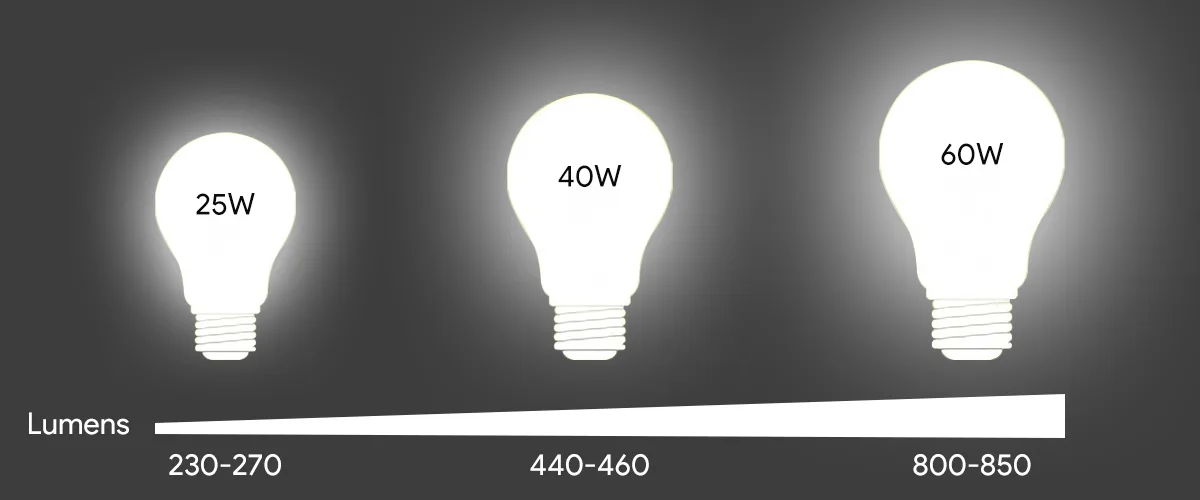
Lumens representam a saída total de luz de uma fonte de luz em todas as direções ou quanta luz uma lâmpada pode “liberar”. Portanto, ao entender os parâmetros de iluminação, os lúmens geralmente são os indicadores mais intuitivos e comuns.
Por exemplo, uma lâmpada LED rotulada como 800 lúmens significa que ela pode fornecer uma saída de luz equivalente a uma lâmpada incandescente tradicional de 60 watts. Esse valor nos ajuda a comparar rapidamente o brilho de diferentes produtos na compra de luminárias, pois os lúmens são uma propriedade inerente à própria fonte de luz e são independentes do ambiente de instalação.
Os lúmens são mais adequados para medir a potência de saída de uma fonte de luz, mas não podem indicar diretamente o efeito da luz em um ambiente real. Em outras palavras, mesmo que duas luzes tenham o mesmo valor de lúmens, seu brilho visual pode ser completamente diferente em diferentes espaços ou com diferentes métodos de instalação.
Leitura relacionada:
Compreender a diferença entre Kelvins e Lumens
Quantos lúmens eu preciso para o meu espaço?
O que é Lux?
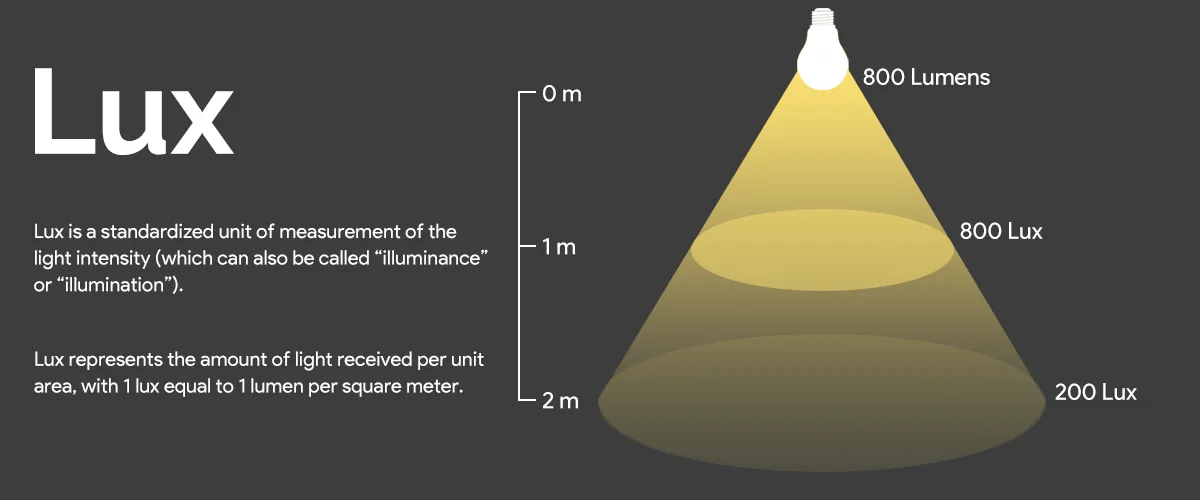
Lux representa a quantidade de luz recebida por unidade de área, com 1 lux igual a 1 lúmen por metro quadrado. O Lux é um indicador chave para avaliar a qualidade da iluminação, porque o que determina a experiência do olho humano não é a quantidade de luz que a luminária emite, mas a intensidade dessa luz quando ela realmente atinge nossa área de atividade. Em contraste, o Lux (LUX) está mais alinhado com a experiência real do usuário.
O Lux não mede a própria fonte de luz, mas sim quanta luz realmente ilumina uma superfície - como uma mesa, uma bancada da cozinha ou uma vitrine. O Lux pode ser entendido como resultado da distribuição de lúmens em uma determinada área, tornando-se uma medida mais intuitiva para saber se um espaço é suficientemente brilhante.
Mais importante, Lux tem uma relação direta com a distância. Quanto mais próxima a fonte de luz estiver da superfície, mais concentrada será a intensidade da luz por unidade de área, resultando em um valor de Lux mais alto; inversamente, quando a fonte de luz estiver mais distante, os mesmos lúmens serão distribuídos em uma área maior, levando a uma diminuição significativa nos valores de Lux.
Isso é facilmente observável em exemplos do mundo real: uma luz de 1.000 lúmens colocada a 1 metro de distância de uma mesa pode atingir várias centenas de lux, mas se instalada em um teto de 3 a 4 metros de altura, a iluminância na mesa diminuiria drasticamente.
Diferenças entre Lumens e Lux
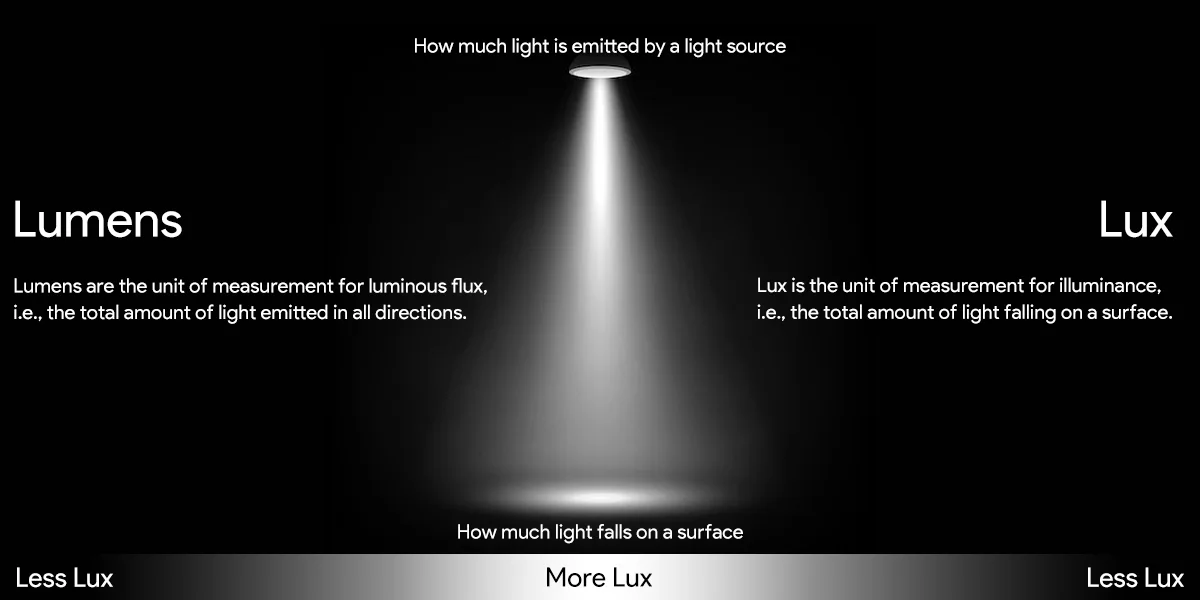
As diferenças centrais entre os lúmens e o Lux podem ser resumidas da seguinte forma:
- Os lúmens são a unidade de medida do fluxo luminoso, ou seja, a quantidade total de luz emitida em todas as direções.
- Lux é a unidade de medida para iluminância, ou seja, a quantidade total de luz que cai sobre uma superfície.
Os lúmens são sempre constantes, mas o lux varia com a distância e o tamanho do espaço. Por esse motivo, não se pode determinar se um espaço está suficientemente iluminado observando apenas os lúmens da luminária; deve-se também considerar o Lux para avaliação.
A partir dessas duas definições, fica claro que os Lumens e o Lux não são conceitos mutuamente exclusivos, mas descrevem a luz de diferentes perspectivas. O primeiro nos diz quanta luz uma fonte de luz pode emitir, enquanto a segunda nos informa quanta luz o olho humano pode perceber em um ambiente específico. Somente combinando ambos, podemos determinar cientificamente se uma luminária é realmente adequada para um cenário de aplicativo específico.
A diferença e conexão entre Lumens e Lux
Na seção anterior, introduzimos as definições e diferenças centrais entre o Lumens e o Lux, mas em aplicações práticas, elas geralmente são confusas. A diferença fundamental está no fato de que os lúmens se concentram na saída total da própria fonte de luz LED, enquanto a Lux se concentra em como essa luz é distribuída em um espaço ou superfície específica.
Você pode pensar nos lúmens como a “taxa de fluxo de uma torneira”, enquanto Lux é a “espessura da camada de água formada quando a água atinge o solo”. A mesma taxa de fluxo resultará em águas profundas se cair em um pequeno recipiente, mas parecerá fina se se espalhar por uma grande área.
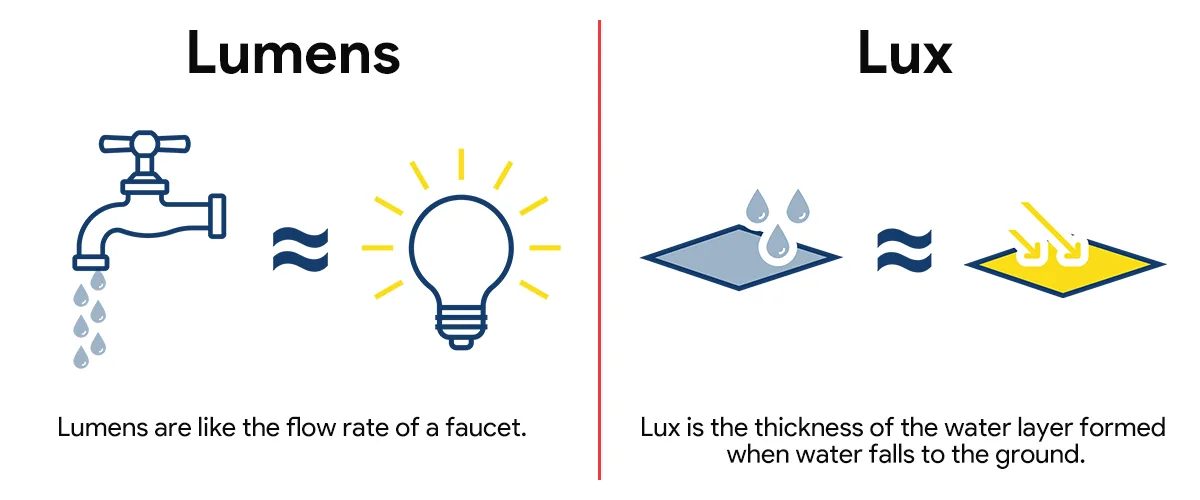
Da mesma forma, mesmo que uma luz tenha uma classificação de lúmens alta, se ela for instalada em um teto muito alto ou tiver uma ampla faixa de distribuição de luz, o Lux na área de trabalho ainda pode ser insuficiente.
Essa distinção também pode ser expressa intuitivamente com uma fórmula:
Lux = Lumens/Área
Em outras palavras, a Iluminância (LUX) é igual à saída total de luz (lúmens) da fonte de luz dividida pela área a ser iluminada. Isso também explica por que a mesma luminária pode parecer muito diferente em diferentes ambientes. Por exemplo, uma luminária com 1.000 lúmens pode parecer muito brilhante em uma pequena sala, mas escurecida em um grande salão. Isso não ocorre porque o valor do lúmen da lâmpada mudou, mas porque o valor do lux diminui à medida que a área aumenta.
Por outro lado, o Lux também está intimamente relacionado à distância entre a fonte de luz e a superfície alvo. À medida que a distância aumenta, a luz se espalha mais amplamente, de modo que a quantidade de luz recebida por unidade diminui e o valor do Lux diminui. No entanto, os lúmens permanecem constantes porque a quantidade total de luz emitida pela fonte de luz não mudou. Os lúmens determinam o “potencial” da luz, enquanto o Lux determina seu “desempenho” em ambientes reais.
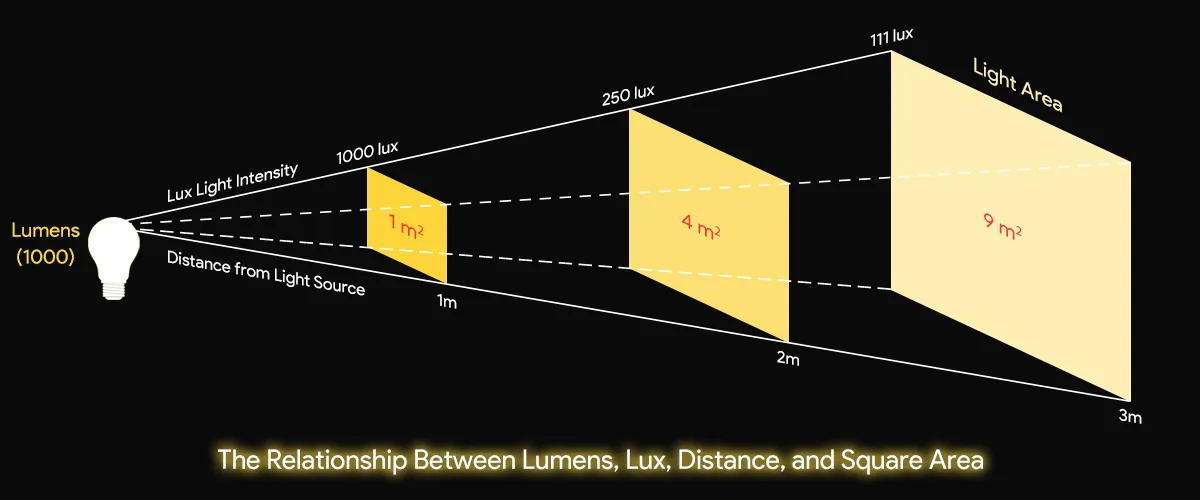
Como tal, Lumens e Lux não são conceitos isolados, mas complementares. A Lumens nos ajuda a entender a capacidade de saída de luz das luminárias de LED do lado da oferta, enquanto a Lux nos permite avaliar os efeitos reais da iluminação no ambiente pelo lado da demanda.
Se considerarmos apenas os lúmens, podemos sentir que a iluminação é insuficiente em espaços grandes; se considerarmos apenas o Lux, ignorando a capacidade de saída inerente do aparelho de LED, podemos subestimar a adequação do aparelho ao espaço durante a seleção. Portanto, no projeto de iluminação real e na seleção de luminárias de LED, essas duas métricas devem ser usadas em conjunto para obter uma avaliação abrangente e precisa.
Quando você deve usar lúmens? Quando deve simou se concentra em lux?
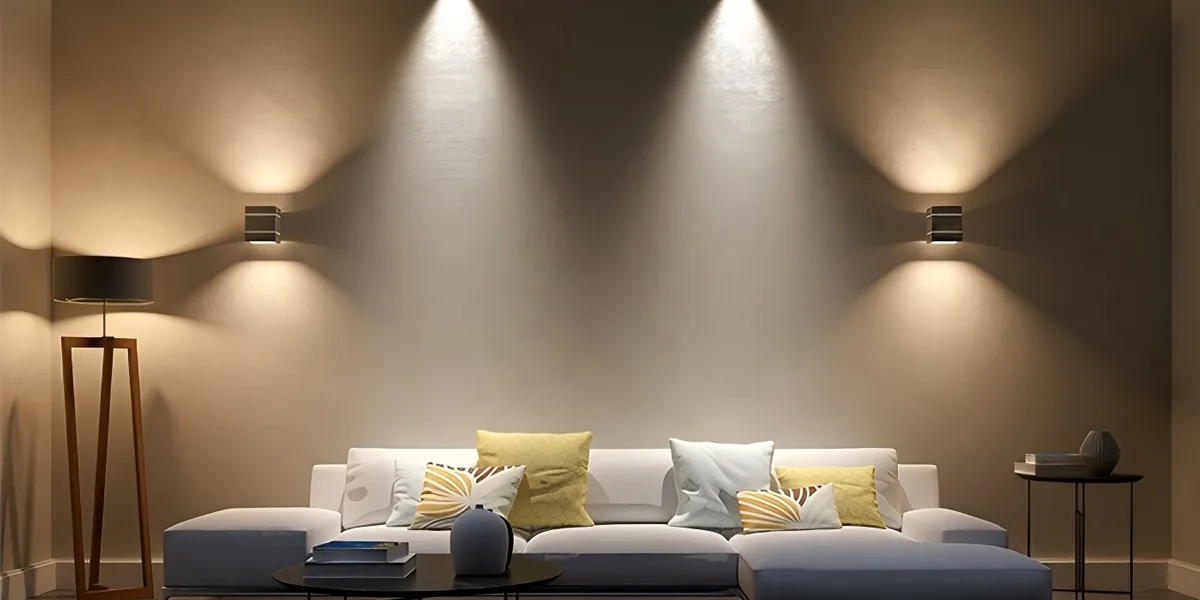
Após entender as diferenças e conexões entre Lumens e Lux, surge uma pergunta comum: em diferentes situações, em qual métrica devemos nos concentrar?
Os lúmens são adequados para comparações horizontais, enquanto o Lux é a métrica que deve ser focada na condução de um projeto de iluminação detalhado. Por outro lado, os lúmens são cruciais para entender a quantidade de luz que uma única fonte de luz emite. Isso é útil para comparar a saída total de lâmpadas, mas não pode determinar se a iluminância é “suficiente” para um espaço ou tarefa com base em sua distribuição de luz e no tamanho do espaço.
Portanto, somente entendendo os cenários apropriados para cada um, podemos alcançar eficiência e precisão na seleção de iluminação.
Quando queremos entender o brilho geral de uma luminária, o Lumens é a referência mais direta. Por exemplo, ao selecionar lâmpadas LED, os consumidores normalmente comparam suas classificações de lúmen para determinar se podem substituir as lâmpadas incandescentes tradicionais de 40W, 60W ou 100W. Nesses casos, os lúmens fornecem uma referência rápida de comparação. Portanto, em configurações de varejo ou comparações de produtos, o Lumens é uma métrica indispensável.
No entanto, se estivermos preocupados em saber se uma área específica é suficientemente brilhante, o Lux é uma referência mais significativa. O Lux é a métrica mais diretamente relacionada às atividades humanas, pois mede a iluminância real na superfície da tarefa de iluminação. Afinal, o olho humano não percebe a quantidade total de luz emitida por uma fonte de luz, mas sim a iluminância dessa luz, pois ela cai em superfícies como mesas, livros ou bancadas de trabalho.
Por exemplo, ao projetar uma área de leitura, precisamos garantir que haja lux suficiente na mesa para garantir conforto e proteção para os olhos; no design de iluminação do balcão da cozinha, o valor LUX determina diretamente a segurança do processo de cozimento; em ambientes de fotografia, exibição ou laboratório, o LUX é a métrica chave para avaliar se a iluminação atende aos padrões profissionais.
A seguir, alguns níveis comuns de Lux:
| SCenes | Lux Valuvião |
| Noite clara (sem lua) | 0,002 lx |
| Noite clara (lua cheia) | 0,27-1 LX |
| sala de estar em família | 50 lx |
| nascer/pôr do sol | 300-500 lx |
| dia nublado | 1000 lx |
| Luz do dia | 10.000-25.000 LX |
| luz solar direta | 32.000-130.000 LX |
Ferramentas e métodos de medição de lúmens e lux
Após entender os conceitos de lúmens e lux, outra questão comum é: como são medidos esses valores? Existem diferenças significativas entre os dois em termos de métodos de medição.
Medir lúmens é muito mais complexo. Como representa o fluxo luminoso total emitido por uma fonte de luz em todas as direções, a luminária deve ser colocada em um dispositivo especial para obter valores precisos.
As ferramentas comumente usadas são integrar fotômetros de distribuição de esferas ou IES. Esses dispositivos coletam e refletem uniformemente toda a luz emitida pela fonte de luz e calculam o valor geral do lúmen usando sensores profissionais e sistemas de cálculo óptico correspondentes.

Como esse processo de medição requer equipamentos especializados e um ambiente experimental estrito, os lúmens são normalmente fornecidos por fabricantes de iluminação LED ou laboratórios durante os testes, e os consumidores raramente os medem.
A medição de Lux é relativamente simples. Como o Lux se concentra na iluminância em uma superfície específica, apenas um dispositivo de medição precisa ser colocado no local de destino.
As ferramentas comuns incluem fotômetros portáteis, que podem exibir diretamente o valor LUX nesse ponto. Isso permite que os usuários comuns avalie rapidamente se a iluminação é adequada em ambientes domésticos ou de escritório. A conveniência desse método torna o Lux mais fácil de avaliar diretamente em aplicações práticas e, portanto, é amplamente utilizado como padrão de iluminação.
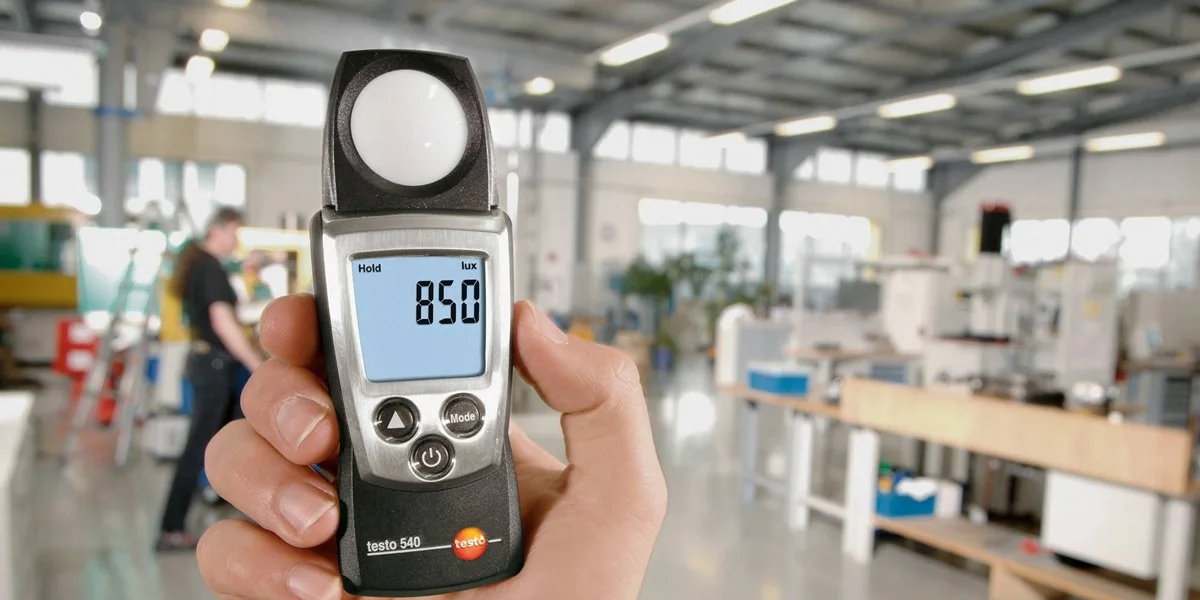
Pode-se observar que as medições de LUX estão mais alinhadas com a vida diária, tornando conveniente para usuários e designers verificarem os efeitos da iluminação em cenários do mundo real, enquanto as medições do lúmen dependem mais de métodos profissionais e servem como uma base importante para o teste e a comparação de desempenho do produto. Essa diferença mais uma vez destaca que, embora Lux e Lumens estejam intimamente relacionados no conceito, seus papéis na operação prática e na aplicação são totalmente distintos.
Lux em aplicações práticas: níveis de iluminância recomendados para diferentes espaços
Para entender verdadeiramente o valor do Lux, ele deve ser considerado no contexto de espaços e tarefas específicas. Diferentes ambientes residenciais ou de trabalho têm requisitos variados para níveis de iluminância.
Embora existam recomendações gerais para lugares como casas ou restaurantes, locais específicos podem exigir níveis específicos de Lux. Por exemplo, a lista a seguir mostra os valores de iluminância exigidos para locais com características específicas:
| Locais especiais | luxúria Valuvião |
| Cozinha (área de trabalho) | 500–600 lx |
| Cozinha (área geral) | 200–300 lx |
| Quarto ( cabeceira ou área de leitura) | 500 lx |
| Quarto (área geral) | 100–200 lx |
| Quarto infantil (área de recreação) | 300 lx |
| Sala de estar (áreas gerais) | 200–300 lx |
| Sala de estar (área de TV) | 50 lx |
| Área de estudo/leitura | 500 lx |
| Banheiro (áreas gerais) | 200 lx |
| Banheiro (áreas do espelho) | 300–500 lx |
| Corredor (corredores ou escadas) | 100–200 lx |
| Oficina | 150-500 LX |
| mesa de escritório | 500-750 LX |
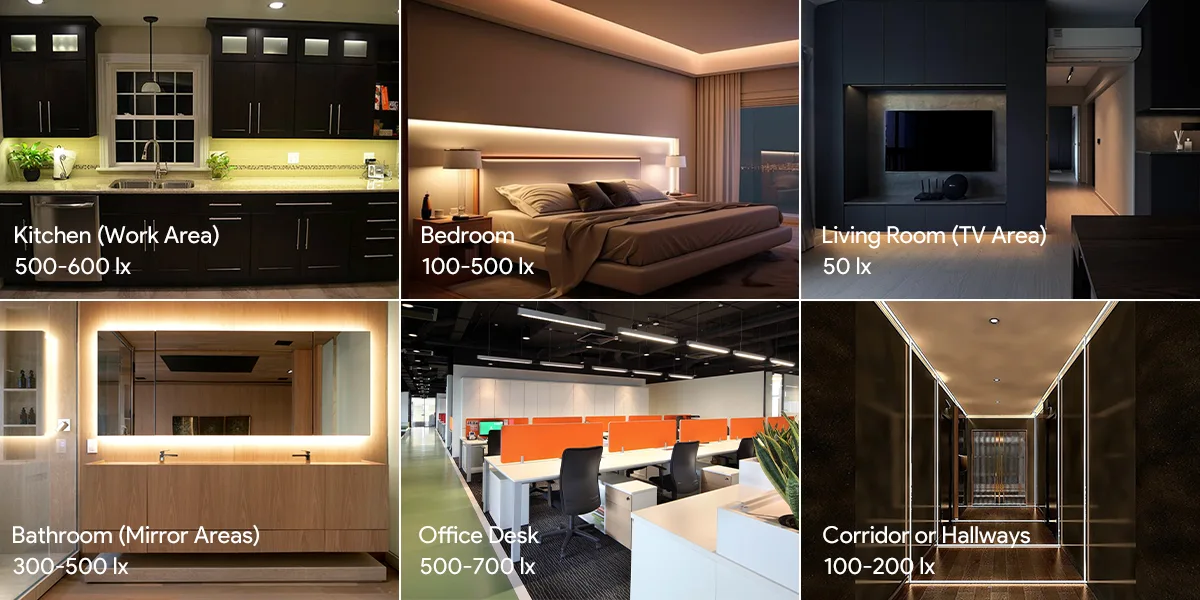
Esses valores nos lembram que, ao selecionar luminárias, não podemos confiar exclusivamente nos lúmens para determinar a adequação. Os lúmens indicam a quantidade de luz da própria luminária, mas se ele atende às necessidades reais, depende do cálculo do Lux necessário com base na área de espaço e na tarefa de uso.
Por exemplo, se o objetivo é fornecer 500 lux de iluminação para uma área de leitura de 10 metros, um total de aproximadamente 5.000 lúmens de fontes de luz deve ser distribuído por toda a área; no entanto, se apenas uma única fonte de luz de 2.000 lúmens for usada, mesmo que os parâmetros pareçam “brilhantes”, o efeito final ainda será insuficiente.
Portanto, o Lux fornece uma diretriz de uso mais clara, enquanto a Lumens fornece os dados fundamentais para selecionar as luminárias. A combinação permite a configuração científica e razoável dos sistemas de iluminação LED, garantindo que cada espaço seja confortável e eficiente.
Resumo
No campo de iluminação LED, Lumens e Lux são dois conceitos que são frequentemente mencionados, mas muitas vezes confundidos. Conforme descrito anteriormente, os lúmens representam a saída geral de uma fonte de luz, servindo como métrica para o brilho potencial de uma luminária; a Lux, por outro lado, mede a distribuição da luz em uma superfície específica ou em um espaço específico, alinhando-se mais de perto com nossa experiência do mundo real durante o uso diário. Embora os dois conceitos tenham diferenças distintas, eles também estão intimamente interligados.
Em aplicações práticas, os lúmens são mais adequados para comparar as capacidades de saída de diferentes luminárias, ajudando-nos a avaliar rapidamente “como essa luz pode ser brilhante” ao selecionar produtos; a Lux, por outro lado, está diretamente ligada à iluminação da tarefa, determinando fatores como conforto de leitura, segurança na cozinha e clareza durante a aplicação de maquiagem na frente de um espelho. Compreender essa distinção pode nos ajudar a tomar decisões mais informadas cientificamente ao planejar a iluminação.
Mais importante, a qualidade de um ambiente de iluminação nunca é determinada por um único valor numérico. Um projeto de iluminação verdadeiramente razoável deve considerar simultaneamente o fornecimento de lúmens e a demanda por Lux, garantindo que a luz tenha uma saída suficiente e distribuída adequadamente para onde for necessário. Só então um espaço pode ser eficiente, confortável e alinhado com os hábitos de uso das pessoas.
Você está procurando soluções de iluminação LED de alta qualidade? A Signliteld tem mais de 14 anos de experiência profissional, especializada em Fitas de LED, tubos de sinal de led, luzes lineares led, e Luzes LED de tripla proteção. Oferecemos produtos confiáveis, eficientes em termos de energia e personalizáveis para atender às suas necessidades personalizadas. Entre em contato conosco hoje para explorar nossas soluções de iluminação inovadoras e elevar seu projeto.
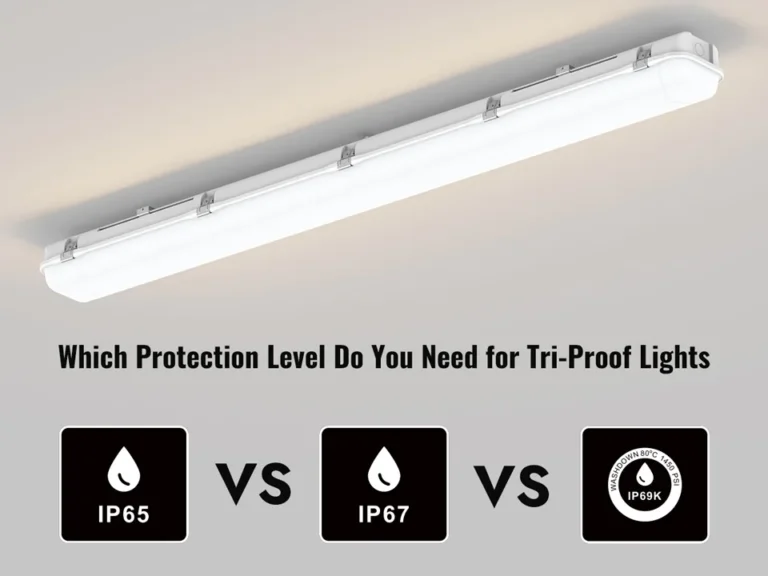

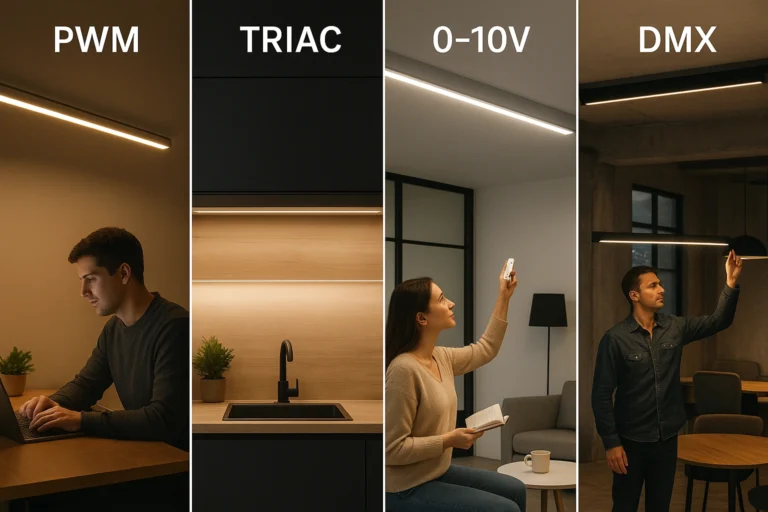


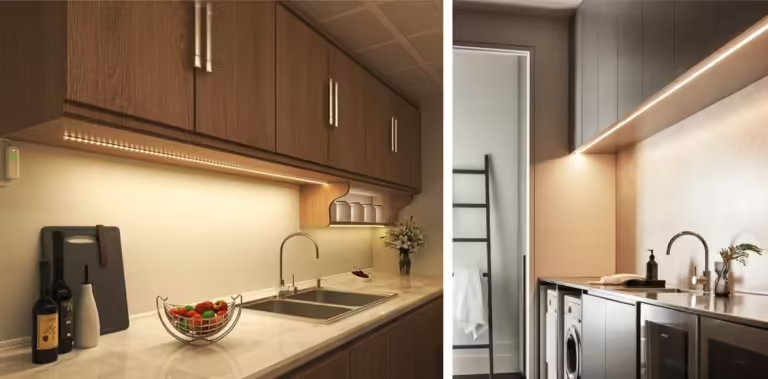

Seu blog se tornou um recurso indispensável para mim. Estou sempre animado para ver quais novos insights você tem a oferecer. Obrigado por fornecer conteúdo de alto nível consistentemente!
O que eu não percebo é como você não é mais bem mais bem do que você pode ser agora Você é muito inteligente Você reconhece muito em relação a este tópico, me fez, a meu ver, acreditar em vários ângulos, é como se homens e mulheres não estivessem fascinados até que seja uma coisa a ver com Lady Gaga, suas próprias coisas, excelentes, todo o tempo, lidam com isso, é como se homens e mulheres não estivessem fascinados até que seja uma coisa a ver com Lady Gaga, suas próprias coisas, excelentes, todo o tempo, lidará com isso, como homens e mulheres, como homens e mulheres não são fascinados até que seja uma coisa a ver com Lady Gaga, excelentes coisas, todo o tempo,
Eu acredito que todas as ideias que você apresentou para o seu post são realmente convincentes e certamente funcionarão, mas as postagens são muito curtas para os novatos, você pode alongá-los um pouco do tempo posterior, obrigado pelo post
Normalmente eu não leio o artigo em blogs, mas gostaria de dizer que este artigo me obrigou a dar uma olhada e fazê-lo, seu gosto de escrita me surpreendeu, muito bom post